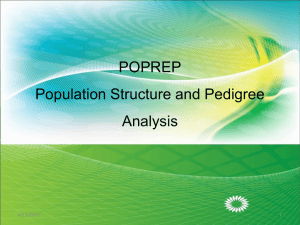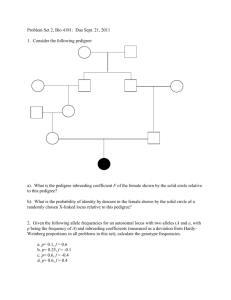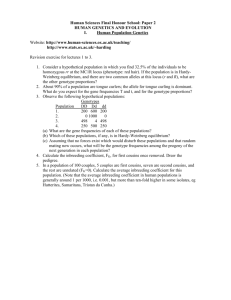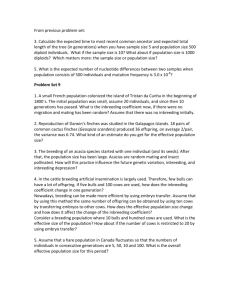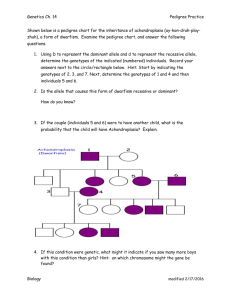SavetheCondors_ExecutiveSummary
advertisement
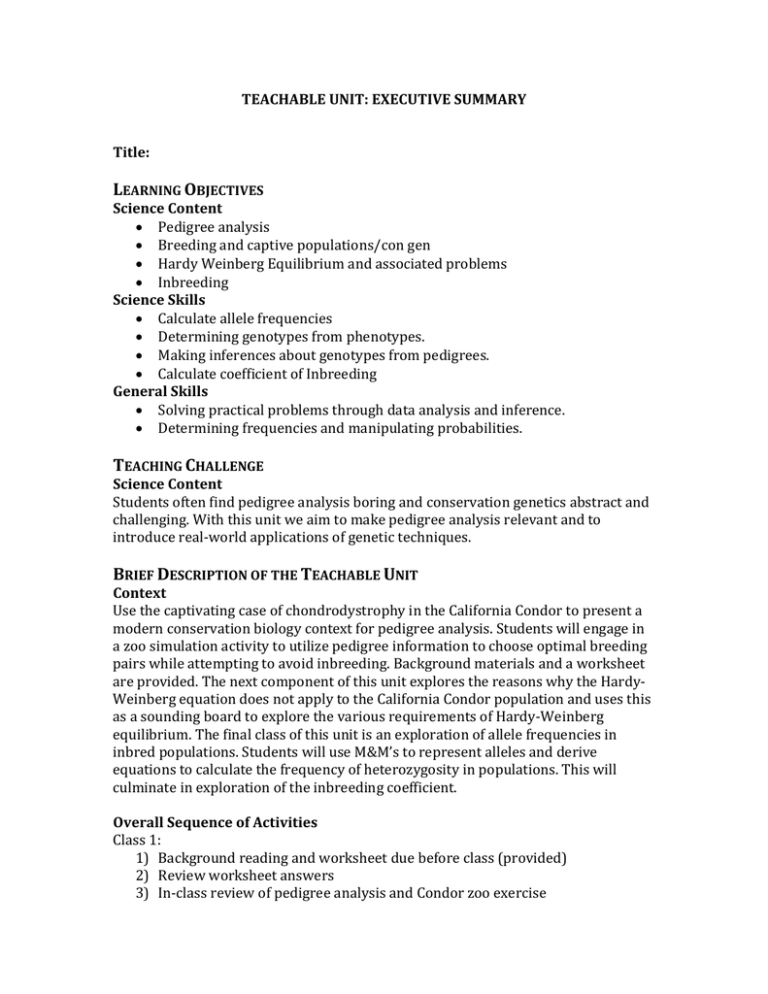
TEACHABLE UNIT: EXECUTIVE SUMMARY Title: LEARNING OBJECTIVES Science Content Pedigree analysis Breeding and captive populations/con gen Hardy Weinberg Equilibrium and associated problems Inbreeding Science Skills Calculate allele frequencies Determining genotypes from phenotypes. Making inferences about genotypes from pedigrees. Calculate coefficient of Inbreeding General Skills Solving practical problems through data analysis and inference. Determining frequencies and manipulating probabilities. TEACHING CHALLENGE Science Content Students often find pedigree analysis boring and conservation genetics abstract and challenging. With this unit we aim to make pedigree analysis relevant and to introduce real-world applications of genetic techniques. BRIEF DESCRIPTION OF THE TEACHABLE UNIT Context Use the captivating case of chondrodystrophy in the California Condor to present a modern conservation biology context for pedigree analysis. Students will engage in a zoo simulation activity to utilize pedigree information to choose optimal breeding pairs while attempting to avoid inbreeding. Background materials and a worksheet are provided. The next component of this unit explores the reasons why the HardyWeinberg equation does not apply to the California Condor population and uses this as a sounding board to explore the various requirements of Hardy-Weinberg equilibrium. The final class of this unit is an exploration of allele frequencies in inbred populations. Students will use M&M’s to represent alleles and derive equations to calculate the frequency of heterozygosity in populations. This will culminate in exploration of the inbreeding coefficient. Overall Sequence of Activities Class 1: 1) Background reading and worksheet due before class (provided) 2) Review worksheet answers 3) In-class review of pedigree analysis and Condor zoo exercise Pre-assessment: Worksheet Set-Up: Instructor must make photocopies of Condor pedigree and provide index cards labeled with the numbers to represent individuals from the population. (See template.) Activity: Managing breeding populations of the endangered California Condor. Students will roll play different zoos each with a pre-determined number of individuals from the California Condor population. Each zoo is responsible for determining the best and worst breeding pairs from the individuals based on information from the provided pedigree given attempting to minimize inbreeding. Post-Assessment: An exam question is provided on which students will analyze a pedigree in which students will analyze an albinism pedigree in pet pythons. Students will attempt to maximize albinism and minimize inbreeding. (Provided) Class 2: 1) Background reading on Hardy-Weinberg (from any textbook). 2) Students will complete a worksheet on how to calculate frequencies. 3) Determine whether Hardy-Weinberg equation can be applied to the situation of the California condors. Pre-assessment: Worksheet Set-Up: Photocopy a worksheet listing the requirements of the Hardy-Weinberg equilibrium. Activity: Students will work in their groups from the previous class to determine whether the California condor population fits Hardy-Weinberg equilibrium. Using the worksheet, students will assess each of the requirements and determine how the condor population does or does not fit the model. Several violations should be found. Activity on calculating allele frequencies. Set-Up: Distribute two colors of small candies (M&Ms or other), 20 candies total, with random distribution of colors for each group. Activity: Have students calculate the frequency of each color candy in their allotment. Students will organize candies in groups of two to represent two alleles in diploid organisms, and recalculate allele frequencies (which won’t change). Ask students if they can then calculate allele frequencies using “individuals” as units instead of alleles Wrap-up: discuss inbreeding and ask students to bring a news article on inbreeding to the next class (homework). Remind students to be wary of offending one another! Class 3: 1) Homework: Students will find a new article from the popular media on inbreeding. 2) Students will share news articles with group members. 3) Ask students which scenario has more inbreeding – How can inbreeding be measured? 4) Introduce inbreeding of coefficient and equation. Activity: Each group will get a single pedigree (at least one of each extreme, two are provided). Remind students how they were able to determine allele frequencies from individuals in the last class. The Ho term should be simple for them. Discuss how they will determine HE. Reflect on the Hardy-Weinberg equation term for heterozygote frequency. Each group will calculate the inbreeding coefficient for their pedigree. Wrap-up: Groups will report their inbreeding coefficient to the class, and discuss which features are common to inbred populations (low frequencies of heterozygotes, higher than expected frequencies of homozygous recessive, etc.) If time allows, return to the news articles students have brought to look for these features. Emily Lilly Amy Welsch Jed Doelling Randy Phillis Stephanie Young Sarah Josway
